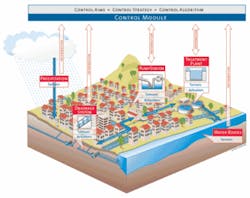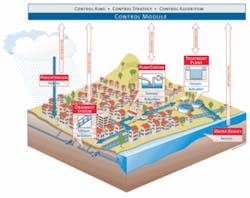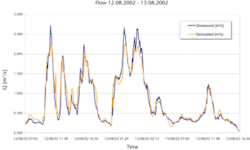Integrated sewage management to reduce pollution load in Berlin
Simulation tools help develop an integrated approach for Berlin's combined sewage system in which sewage overflows pose risk to groundwater and surface water quality.
Berlin is one of the few European metropolises in which drinking water is almost completely supplied by groundwater sources located within the municipal area, and wastewater disposal must be managed within the same area. Drinking water is pumped almost exclusively within city boundaries, having developed in this way throughout its centuries-long urban history.
The close spatial interlock between drinking water supply, wastewater disposal and water use creates a situation of potential conflict. Inevitably, usage conflicts between urban development, water pollution control and groundwater protection makes particular demands.
The full capacity of a complex sewage system must be used to minimise pollutant loads discharged to receiving waters especially during storm weather events. Sewerage system components include sewer networks, storage and control assets, pump stations, pressure mains and wastewater treatment plants.
The KompetenzZentrum Wasser Berlin (Berlin Centre of Competence for Water) launched the "Integrated Sewage Management" project in 2003 in order to minimise the water pollution load within the urban area of Berlin. The key issue of this project is to apply integrated simulation tools to examine different management scenarios, then define and install an integrated operation concept for the system.
The project pays special attention to the combined sewage system in which sewer overflows represent a potential risk for river pollution. Real time control of local regulators and thereby the activation of additional storage capacity within the network can optimise the overall system.
The size and complexity of the sewage system in Berlin creates particular challenges to the work. The system serves 3.5 million inhabitants and connects an area of some 900 km2. The total length of collectors is approximately 9,000 km. Three-quarters of Berlin is drained via the separate system, whereas in the inner city, one quarter of the total area drains into the combined system. One hundred and forty-nine pump stations transport wastewater through more than 1,000 km of pressurised pipelines to six wastewater treatment plants for mechanical and biological treatment. On average, a total of approximately 635,000 m3 wastewater are delivered and cleaned per day.
The project is scheduled in four main phases. Phase I included a state-of-the-art study of the Berlin sewerage system that produced a comprehensive report that documents in detail the structures, assets and processes, including their interfaces, to obtain a reliable data set and more information to revert to during all phases of the study.
Phase II of the project compared different models used by the project partners, the French company Veolia Water and Berliner Wasserbetriebe of Germany. This phase was expected to gain experience and to acquire an overview on different model approaches by assessing their performance and transferability. InfoWorks CSTM of Wallingford Software Limited is being used to set up the network model in order to find models that can be used within a combined methodology to improve the Berlin sewerage system. In order to model the wastewater treatment plants, the modular program SIMBA®, created by ifak e.V. Magdeburg, is used to model wastewater treatment plants. The program is based on the Activated Sludge Model No. 1 (ASM1).
Phase III will result in the development of an integrated model for a specified part of the Berlin sewage system, the subsystem of the wastewater treatment plant Ruhleben, to acquire a simulator for the network and the wastewater treatment plant. The Ruhleben wastewater treatment plant handles flows from 1.6 million inhabitants and is connected to an area of around 150 km2 . Plant capacity is 240,000 m3/d for dry weather flow.
Finally, phase IV of the project will provide a general study and the design of a management policy for the entire Berlin sewage system.
Analysis of control potential
The German ATV-DVWK-workgroup 1.2.4 "Real time control on sewer systems" developed a checklist for the preliminary assessment of a sewer system's control potential. Corresponding to its properties, a sewage system is rated according to its drainage area, sewage accruement, condition and type of receiving water, sewerage network and operational performance. Its control potential determines its classification.
The Berlin system is highly rated because of its low average sewer gradient, the complex network structure with a high number of control, discharge and storage assets, and its large spatial dimensions. It is classified as predestined for real time control.
Model build-up and calibration
Available data on the geometric design of the sewerage system and terrain is taken from the GIS database of the Berliner Wasserbetriebe or from former hydrodynamic calculations in order to set up the model.
All catchments with a share of combined sewers are simulated, but only the main sewers are taken into account. The model consists of low detailed networks that allow with adequate accuracy the simulation of the main hydraulic and pollutant processes within the sewerage system. Subsequently, a phase of model calibration and validation takes place.
Data is continuously recorded at the pump stations and actuators, such as sluice gates and mobile weirs, within the framework of operational monitoring. These data sets are used to perform a calibration of volume, flow and water levels. Additional measurement efforts are carried out at specific catchments to complete the data for calibration and to examine hydraulic and pollution processes in full detail. Figure 1 shows a set of measured flow data during a rain event and the corresponding set of simulated data after model calibration for comparison.
The ISM project is expected to minimise the water pollution load within the urban area of Berlin by regulating the sewerage system in a more efficient, cost-effective way. This will be accomplished by the following three steps.
(1) The optimisation of local regulators, such as pumps, weirs or sluice gates by the computer model. A maximum performance of the regulators will create additional retaining capacities within the combined sewerage system. Hence, discharges via sewer overflows into the receiving water will be reduced and the full capacity of wastewater treatment plants will be used.
The present development of local level-dependent control for pump stations shows that it is necessary to take into account the influence of the individual actuator on the system in addition to the interaction between linked subsystems. Total emissions, not single discharges, from sewer networks and wastewater treatment plants must be balanced. Moreover, the impact on operational processes by adverse effects, such as sedimentation within sewers, must be considered.
A detailed simulation-based study was carried out to derive parameter settings and evaluate the effect of a variable pump control. The results have been analysed with regard to in-sewer processes, the interaction of sewer, pump station and wastewater treatment plant and total emissions. The evaluation shows that operational requirements can be met by setting optimal parameters for actuators. Moreover, if there is an adequate retention volume within the sewer networks a significant improvement of the flow characteristic towards the wastewater treatment plant and a reduction of total emissions is possible.
(2) The development of global control strategies allowing all regulators being operated in a coordinated manner. In this connection, all regulators are operated with respect to process measurements throughout the entire system (Figure 2). This coordination will lead to more uniform utilization of the system.
Spatially non-uniform storm events combined with the wide extension of the Berlin sewage system led to spatially unbalanced flow processes. Furthermore, storage capacities are unevenly distributed within the system. Due to this situation, global control will improve the system's dynamic processes. The preliminary simulation-based assessment of a global control concept showed high potential. Combined sewer activities have been reduced significantly by using inline storage capacities in a coordinated manner.
(3) The transfer and application of the optimised control strategy. Results from model simulation will be transferred to the operator in a fast and applicable form.
Authors Note
Dipl.-Ing. Kai Schroeder is a research engineer at the KompetenzZentrum Wasser Berlin, located in Berlin, Germany. Dipl.-Ing. Erika Pawlowsky-Reusing is the project manager and coordinates research activities with the operational demands of Berliner Wasserbetriebe. For more information, contact the authors at: [email protected] and Erika.Pawlowsky-Reusing @kompetenz-wasser.de or visit the Website: www.kompetenz-wasser.de


